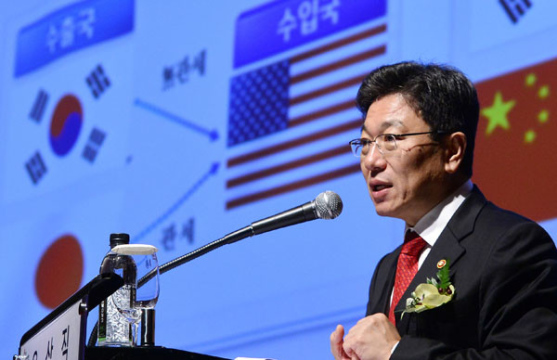
Mexican vs Chinese Factories
With the rising cost of wages in China, manufacturers are increasingly considering Mexico an attractive location to ‘re-shore’ production.
An interview with Héctor Castro Vizcarra, non-resident senior fellow for the Energy, Climate Change & Extractive Industries Program
Nate Graham (Program Assistant, Energy, Climate Change & Extractive Industries): The 2013 reform that liberalized Mexico’s power sector and ended the monopoly of the Federal Electricity Commission (CFE, the state-owned vertically-integrated utility) was heralded by many as a potential watershed moment for renewable energy in Mexico. Energy companies from across the globe flocked to Mexico’s three auctions for long-term power supply contracts between 2015 and 2017, and contracts were awarded to wind and solar projects accounting for a considerable share of new power demand at prices in some cases previously unseen internationally. The reform was accompanied by Clean Energy Certificates (CELs) meant to ensure that ambitious clean energy goals were reached.
However, the administration of President Andrés Manuel López Obrador (AMLO) has not built on this progress or capitalized on Mexico’s vast renewable energy potential and appears not to see the value in renewable energy expansion—even for reducing dependence on energy imports from the United States, a signature promise of his campaign. The head of CFE, Manuel Bartlett, has deemed renewables unreliable and expensive and, with the nationalistic flair typical of this government, stated that his firm will not purchase power produced by private companies because CFE can produce its own. To that end, a fourth highly-anticipated auction was suspended in December 2018 with no rescheduling in sight and the government indicating at one point that the auction had been cancelled entirely. With Mexican energy demand continuing to grow and generators continuing to seek investment opportunities, Bravos Energía, a private energy consultancy led by some of the designers of the Mexican government’s long-term auctions, is holding an auction of its own.
Meanwhile, new rules published by the energy ministry will extend CELs to clean energy generators built before 2014, weakening a major incentive to renewable energy development in Mexico and jeopardizing ongoing investments, according to critics.
Have the sunny prospects for renewable energy in Mexico dimmed, or can private companies weather the AMLO administration’s unfavorable disposition toward renewables? I turned to the Energy, Climate Change & Extractive Industries Program’s non-resident senior fellow, Héctor Castro Vizcarra, the former representative of the Mexican energy ministry in Washington, DC, for answers about what the private energy auction and the CEL rule change mean for the sector.
Nate Graham: What features make Bravos Energía’s private long-term electricity auction a significant development in the absence of government auctions? Will it be able to achieve results on the same scale?
Héctor Castro Vizcarra: With 70 companies registered, Bravos Energía’s ability to attract a wide range of participants has poised it for success when its results are announced in January. The initiative fills an important strategic role in the Mexican energy sector that, at least for the time-being, has been left empty by the suspension of the Mexican government’s long-term power auctions. That is the role of bringing investment to Mexico, generating large volumes of power at extremely competitive prices, and advancing towards Mexico’s clean energy goals using a transparent and accountable mechanism that prioritizes technical and financial viability. However, it is not necessarily a substitute for the public auctions, which were designed for the CFE basic suppliers, whereas the private auction is designed for a different set of players—all qualified users and qualified suppliers. So far CFE, which purchased almost all the energy in the three government auctions, is not expected to participate, and its participation is not deemed necessary for this auction’s success. There are also important differences in the auction designs.
Mexico’s three previous long-term power auctions were organized by the independent power system operator, CENACE, between 2015 and 2017 following Mexico’s 2013 liberalization of the energy sector. These tenders yielded major benefits for developers and the state alike. They generated contracts with 56 power plants with combined installed capacity of 7,666 MW and commitments of more than 10 billion dollars of investment, with little risk to the Mexican state. The contracts provided long-term revenue certainty, making projects more attractive for financing. The design of the auctions incentivized the generation of energy near demand centers and created competition between clean technologies, driving down prices and producing savings for CFE Basic Supply, the state-owned distributor. And the introduction of significant wind and solar capacity contributed to the diversification of Mexico’s energy matrix and reduction of greenhouse gas emissions. The fourth auction, scheduled for December 2018, was poised to build on these successes but was suspended by the government. Almost a year later, whether or when it will take place is unclear.
Enter Bravos Energía’s Long-Term Electrical Auction (CELP). As in the government auctions, companies can trade capacity, generation, and CELs, as well as a new product called energy balancing, which is flexible capacity that can be deployed as grid variations require. The CELP seeks to encourage clean energy investment and produce low prices while adding flexibility and security to the National Electric System.
The design of the CELP has several important benefits worth noting. Contract lengths are flexible at either five, ten, or fifteen years. By contrast, in the government auctions they have only been for 15 years, or 20 years for CELs. The new product, energy balancing, reduces exposure to spot market prices. Offers of energy are differentiated by both node and place of delivery, competition drives down prices, energy production near the centers of greatest demand is incentivized, and the process catalyzes geographical and technological diversification of power generation, as well as diversified and managed credit risk. The process also provides a transparent operation and a neutral arbiter.
In sum, private energy auctions are an exciting new opportunity to trade large volumes of new generation at competitive prices, bolstering Mexico’s energy security, economic growth, and clean energy efforts.
Nate Graham: What are the specifics of the government’s recent modification to CEL rules, and what is the rationale for the change? What concrete effect will the CEL rule change have on renewable energy contracts in Mexico and the government’s general relationship with the private sector?
Héctor Castro Vizcarra: On October 28, Mexico’s Ministry of Energy (Sener) published new guidelines for CELs that will allow the delivery of CELs to CFE plants (mostly large hydroelectric) built before 2014, despite warnings about the rule change’s potential consequences. CELs, awarded for each MWh of energy produced by clean sources, are tradeable and generators must acquire them each year in an amount corresponding to a gradually increasing share of generation from clean sources (in 2019, 5.8%). They are the principal tool of the Mexican energy reform’s goal to incentivize new renewable energy investment, as renewable generators can sell their excess CELs to other generators with lower shares of clean energy generation. They were meant to facilitate compliance with a mandatory goal of 35% clean energy nationwide by 2024.
Rocío Nahle, the secretary of energy, sees the move as a matter of equity for CFE, whose 60 pre-existing hydroelectric plants were left out of the CEL scheme when it was introduced as part of the 2013 energy reform. In a radio interview with the program Fórmula Financiera she called CELs a “subsidy for clean energy” and cited a projection that the Mexican government (through CFE) will pay 80 billion pesos (about $4.17 billion USD) over the next 20 years to purchase clean energy and CELs to meet clean energy generation requirements. According to Nahle, by granting CELs to CFE projects established before August 2014, this bill will be cut by some 60%.
The changes have drawn criticism from both the private sector and regulators and threaten investment in Mexican renewable energy as well as the country’s commitments under the Paris Climate Agreement. Furthermore, they violate President López Obrador’s avowal that he would not modify the energy reform and constitute another instance of the current administration retroactively changing the rules of the game for private companies.
Opponents of the move argue that retroactively extending CELs to legacy projects could create a vast oversupply and decrease their value in incentivizing clean energy development. In fact, Mexico’s Coordinating Business Council (CCE) warns that the new guidelines put more than $9 billion dollars of domestic and international renewable investment, which was anchored in the original rules, at risk. CCE has declared that the change of rules substantially alters the regulatory framework of the energy sector, generates uncertainty, and threatens the execution of investments. CCE has announced that it will defend itself legally.
The Mexican Solar Energy Association (Asolmex) and Mexican Wind Energy Association (AMDEE) have also issued reminders that a major attraction of allocating resources to renewable projects is in the possibility of commercializing CELs. Under the new rules, projects with an original payback period of 10-20 years may now not recover their investments for 20-30 years. Asolmex has stated that the changes will prevent $1.5 billion in solar investment this year, out of $3.5 billion previously expected, and announced that they will go to national and international authorities to defend their rights. And, in a recently published text, the Mexico Climate and Energy Platform says that this maneuver allows the Mexican government to take advantage of its old clean generation capacity to pretend to comply with CEL obligations while not installing new plants, generating clean energy with new facilities, or paying for CELs at auction.
Even the CRE, Mexico’s Energy Regulatory Commission, warns that the new rules discourage the construction of new renewable energy plants.
In this latest confrontation between the Mexican government and the private energy sector, the government is changing the rules to allow CFE to simulate compliance with pre-established clean energy goals and undermining the energy reform that AMLO said he would not change. Despite the veneer of cooperation constructed by the roundtable, speeches, and photographs surrounding the recent renegotiation of pipeline contracts, this new development is additional evidence that the relationship between the government and private industry is frayed by repeated instances of the administration rewriting the rules. Unfortunately, the outcomes of the pipeline controversy, in which the government wielded the threat of international arbitration to renegotiate contracts, suggest that private companies will struggle to win this battle in court.
Can Mexico Run on Clean Energy? (Op-ed)
Mexico’s Renewable Energy Future (Report)
The Outlook for Renewable Energy under the AMLO Administration (Presentation)
Regulators and Companies Still Central to Mexico’s Energy Sector (Event summary)
The Unfinished Business of Mexico’s Energy Reform (Event summary)
Energy Policies under the AMLO Administration: Impact on US-Mexico Energy Trade (Presentation)
Mexico’s Problematic Energy Policy (Interview)
Mexico and Brazil’s Crude Politics (Op-ed)
What Will AMLO and Bolsonaro Do To Energy Markets? (Podcast)
With the rising cost of wages in China, manufacturers are increasingly considering Mexico an attractive location to ‘re-shore’ production.
Colombian firm Interbolsa is being liquidated in a move to protect the interests of Colombia’s financial markets.
South Korea’s entry into the TPP will promote stronger cooperation between South Korea and Latin America.
